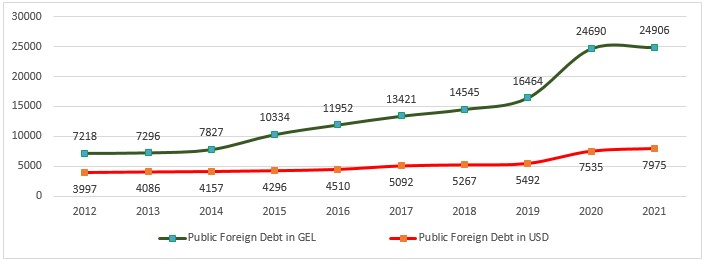Zurab Girchi Japaridze: “Under this government, the debt passed the critical 60% threshold and is over 65%.”
Verdict: FactCheck concludes that Zurab Girchi Japaridze’s statement is HALF TRUE.
Resume:
As of September 2021 data, Georgia’s public debt is GEL 30.3 billion which is GEL 517 million as compared to December 2020. Since there is an economic growth trend in 2021, it is expected that Georgia’s public debt to the gross domestic product ratio will be under 60% and, therefore, Zurab Girchi Japaridze’s statement that the debt is currently over 65% is irrelevant. In 2020, Georgia’s public debt to the GDP ratio was 62.5%. As of September, the public debt to the expected GDP ratio is 53.1%.
As of September 2021’s data, Georgia’s public debt has increased 3.6 times as compared to 2012. However, the relative figure (the debt to the expected GDP ratio) increased nearly 1.7 times whilst the public debt to the GDP ratio was nearly two times higher in 2020 as compared to 2012. Of additional mention is that the sharp growth of the public debt is linked to the pandemic and Georgia is certainly not an exception in the world with such a dynamic. According to the pre-pandemic plans, a lesser growth of the public debt was anticipated. In 2019, the public debt to the GDP ratio was 41.9% which was 10.9 percentage points of growth as compared to 2012. On the other hand, the growth of the GEL-denominated debt figure is stipulated by the sharp depreciation of the GEL exchange rate in the last nine years for which the government can only be held partially responsible. Therefore, Zurab Girchi Japaridze’s statement is HALF TRUE.
Analysis
On 20 October 2021, the united opposition’s candidate for the Deputy Mayor of Tbilisi, Zurab Girchi Japaridze, stated: “Under this government, the debt passed the critical 60% threshold and is over 65%.”
Mr Japaridze has not specified whether he is referring to the public debt or the government debt. It is important to differentiate government debt from public debt. The public debt is the sum of the total government debt (domestic and foreign) and the obligations of the National Bank. Discussing the public debt is appropriate for the purposes of analysis and this has been a very topical issue for the last several years. Interest in the public debt particularly surged amid the novel coronavirus pandemic. The public debt consists of the domestic debt denominated in the national currency and the foreign debt denominated in foreign currency.
As of September 2021’s data, Georgia’s public debt is GEL 30.3 billion. Of this amount, GEL 5.4 billion is domestic debt whilst GEL 24.9 billion is foreign debt. Of note is that the amount of the public debt is GEL 517 million less as compared to December 2020. Since there is an economic growth trend in 2021, it is expected that Georgia’s public debt to the gross domestic product ratio will further decrease. As the public debt to the GDP ratio was 62.5% in 2020, it is highly likely that this figure will be under 60% in 2021. According to the current data, the public debt to the expected GDP ratio is 53.1%.
Graph 1: Public Debt Statistics in 2012-2021 (September)

Source: Ministry of Finance, author’s calculations
In 2012, Georgia’s public debt was GEL 8.4 billion which accounted for 31% of GDP. As of September 2021’s data, Georgia’s public debt has increased 3.6 times as compared to 2012. However, the relative figure (the debt to the expected GDP ratio) increased nearly 1.7 times. The public debt to the GDP ratio was nearly two times higher in 2020 as compared to 2012. However, the sharp deterioration of the statistical figure was partially caused by the pandemic situation. Given the pandemic context, Georgia is certainly not an exception in the world in terms of growing debt. One of the standard crisis response mechanisms routinely used of late by the absolute majority of the world’s countries is to stimulate the economy with budget resources and counter-balance surging social problems. The fiscal component of the government’s response affects the country’s budget in two areas – the expenses for social assistance and stimulating the economy grow and economic activity contracts. Therefore, the budget receives less tax incomes as compared to the planned amount. According to the pre-pandemic plans, a lesser growth of the public debt was anticipated.
In 2019, the public debt to the GDP ratio was 41.9% which constitutes 10.9 percentage points of growth as compared to 2012. However, the fluctuation of the GEL exchange rate vis-à-vis USD is something to take into account whilst making a reference to the debt growth. In particular, when the exchange rate changes at the end of a period, it is not only the added debt in a given period (the debt taken in a year) that is calculated with the new exchange rate but also the total debt accumulated for that particular moment. Therefore, debt growth is largely stipulated by a recalculation of the debt taken in the past with the new exchange rate.
Graph 2: Public Foreign Debt, Denominated in GEL and USD in 2012-2021

Source: Ministry of Finance
The growth of the public foreign debt largely accounts for the growth of the total public debt. Graph 2 shows the public foreign debt denominated both in GEL and USD in order to better illustrate the fluctuation sparked by the exchange rate.








